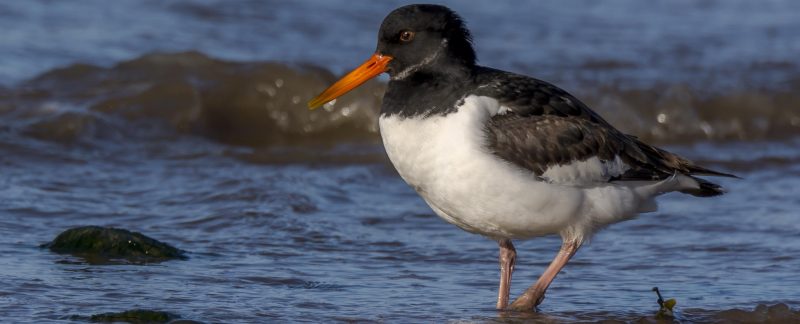Oystercatcher is the species for which the Wash Wader Ringing Group receives the most recoveries (birds seen or recaught away from the original place of ringing) each year. Of the 45 reports received from the BTO in 2018, 22 were of birds reported in the Britain & Ireland with the other 23 being reported broad. The majority of these were of birds ringed by WWRG and recovered elsewhere but eight were birds that were ringed elsewhere and recaught (or resighted) by WWRG; three of the eight had been ringed in Britain & Ireland whilst the other five were ringed abroad.
Most of the Oystercatchers which visit eastern Britain in winter (including the Wash) breed in Norway or the Low Countries (Werenham et al 2002). The 2018 Oystercatcher records reflect this, with the majority of recoveries from Norway and the Netherlands.
Norway is a major breeding area for Oystercatcher. Most of the foreign recoveries of Oystercatcher come from the Rogaland area of southern Norway and, in 2018, included birds captured by ringers (six recoveries), dead birds (five recoveries) and metal rings read in the field (just one recovery).
In addition, there were three recoveries from further north in Norway with FP08571, recovered at Troms, the most northerly at 66° 55m N, a distance of 1,982 km from the Wash.
Other foreign recoveries were of birds from the Netherlands and Denmark including the following:
FA46511, ringed by WWRG at Holbeach St Matthew on 21 August 1993 and subsequently captured on 13 March 2018 at Skagen in Denmark.
FA47184 and FP99607, ringed by WWRG in Lincolnshire on 29 September 1992 and 31 August 2008 respectively, were both found freshly dead in the northern part of the Netherlands, the former on 30 May 2018 and the latter on 31 May 2018.
The most exciting recovery of an Oystercatcher in 2018 was FV27597, ringed at Friskney on 30 July 1976 and recovered at Saint-Pol-sur-Mer in northern France on 4 September 2017. This recovery sent the team rushing to the record books to confirm that this was a new British & Irish longevity record for the species with 41 years 1 month 5 days between ringing and recovery. This bird was at least three years old at the time of ringing and therefore at least 44 years old at the time of its recovery. This Oystercatcher was found dead, having been shot; a sad end for a bird that had lived for such a long time and created a new record. The previous longevity record was held by an Oystercatcher that had been ringed as a chick in Lincolnshire on 14 June 1970 and recovered by WWRG on 16 July 2010, 40 years 1 month and 2 days later (see this Wader Tales blog for more info).
With the increasing availability of good quality optics and cameras, one interesting recent development is the number of reports that are received as a result of birdwatchers resighting metal rings in the field. Unfortunately, the information on the ring numbers is sometimes incomplete and only allows us to narrow the sighting to a particular catch rather than an individual bird.
FP 325_1 read by a finder in Nordland, Norway on 23 June 2016. Although it is not possible to identify an individual bird from an incomplete ring number, this bird would have been ringed during a catch by WWRG on 17 December 2003. This Oystercatcher was seen with a chick, providing evidence of breeding.
FH52527 and FH52569, both ringed by WWRG on 2 August 2015 and resighted at Dawlish Warren NNR in Devon from metal rings read in the field, the former on 24 January 2017 and the latter on 13 February 2018.
FH81255 and FA47184, ringed by WWRG on 13 February 2016 and 29 September 1992 respectively, were re-sighted by birders in the northern part of the Netherlands (Den Helder and Friesland), FH81255 on 4 May 2018 and FA47184 on 21 May 2018. Unfortunately, FA47184 was found dead a week later on 30 May 2018.
FH52407, ringed on 7 March 2015, was a recovery from northern France of a resighting in the field on 22 August 2018, a welcome change from the more common records from France of waders that have been shot.
Reference
Wernham, C.V., Toms, M.P., Marchant, J.H., Clark, J.A., Sitiwardena, G.M. and Baillie, S.R. (eds.) (2002) The Migration Atlas: movements of the birds of Britain and Ireland T. & A.D. Poyser, London.

